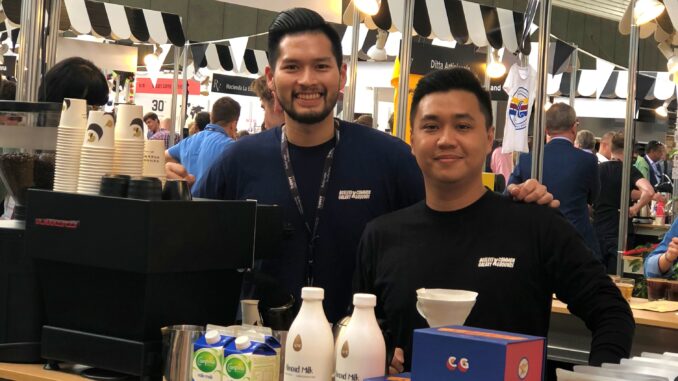
Two-time Indonesia Barista Champion Mikael Jasin explains the perks of running a pop-up café versus a brick-and-mortar shop.
BY EMILY MENESES
SENIOR ONLINE CONTRIBUTOR
Photos courtesy of Mikael Jasin except where noted
For years, street food and food trucks have remained a major part of the food and beverage industry—and the coffee world has found its own version of this phenomenon with the pop-up café. Running a pop-up is a great way to kickstart your shop and build capital before committing to a more permanent option. Or, if you already have a brick-and-mortar café, it’s also a chance to expand your clientele.
Over the years, Mikael Jasin Indonesia’s 2019 and 2020 National Barista Champion, has had his fair share of pop-up café experiences, serving coffee at major events in cities all around the world—including his birth city, Jakarta, Indonesia, and Melbourne, Australia, where he attended college. Mikael shared his insights with us on what it’s like to run a pop-up café, and the benefits of running a nontraditional shop versus a brick-and-mortar shop.
Pros of Starting a Pop-Up Café, as explained by Mikael Jasin:
1. It’s a less risky investment.
If you want to kickstart your business but aren’t ready to commit to a brick-and-mortar café, running a pop-up café is a great place to start.
“Pop-up cafés are very lean,” Mikael shares. “You can set one up with a lot less capital compared to a brick-and-mortar café. Sure, you’ll need a coffee machine and a grinder … but that’s about it.”
“When I was in college in Melbourne,” Mikael continues, “one of my friends actually started a pop-up café. They had a small cart and one espresso machine—but within a year or two, they ended up having four [of them]. I think if the community you’re in already has [a strong] coffee culture, it’s highly possible [to make it as a pop-up].”

2. You’ll widen your audience.
Running a pop-up café is also a great way to expose your brand to a wide variety of people. By working festivals and events, you’ll encounter crowds you may not have necessarily crossed paths with if you were working out of a brick-and-mortar shop.
“I think the best part of [running a pop-up café] is that you get to connect with people you wouldn’t normally meet,” Mikael says. “When you work at a brick-and-mortar café, you’re there every day, and you always see the same people. With pop-up cafés, you can meet different sets of people. It may make things more challenging at times, but from a business perspective, [it’s good because] you get to expose your brand to new audiences.”

3. You’ll learn how to streamline your menu.
Running a pop-up café may force you to have a limited menu, but Mikael points this out as a positive thing.
“Most of the time, you’re working at a very small bar,” he shares, “but that’s good because you streamline things. [With a small menu], it’s very easy for people to choose what they want, rather than having to pick between 20 different items.”
4. It allows more freedom and flexibility.
With pop-up cafés, you have the choice of deciding where and when you wish to operate. Mikael also shares that there are multiple ways to go about running a pop-up café, citing former Indonesian National Barista Champion Yoshua Tanu and his mobile café Jago Coffee as an example.
“(Yoshua) started a mobile coffee company called Jago Coffee,” Mikael shares. “They started out with 10 electric bikes, and now they have 50—and they only serve customers within 15 and 20 kilometers. Now, they have an app, and you can just order through the app and they’ll cycle over to you. They’re still in Jakarta, but they’re trying to copy that model in different cities.”
Mikael explains that Jago Coffee made the process a bit easier for their cyclists by offering bottled coffee, and he cites Yoshua’s company as a great example of how running a pop-up or mobile café can expand your clientele.
“It’s pretty cool! Normally, pop-up cafés rely on foot traffic,” Mikael explains, “whereas, with this, you can actually just cycle to your customers.”
When asked what advice he has for coffee professionals thinking of starting a pop-up café, Jasin shares, “[Wherever you are], just focus on what type of people pass by every day. Eventually, you can start thinking about things in a larger sense – but the focus of a pop-up café should always be serving your immediate community.”
Stay tuned for the next installment of this series, where we’ll explore the possible challenges of running a pop-up café and how to navigate them.
ABOUT THE AUTHOR
Based in Los Angeles, Emily Joy Meneses (she/her) is a writer and musician passionate about culture and collective care. You can regularly find her at Echo Park Lake, drinking a cortado and journaling about astrology, art, Animal Crossing, and her dreams. Explore her poetry, short stories, and soundscapes on her website.




